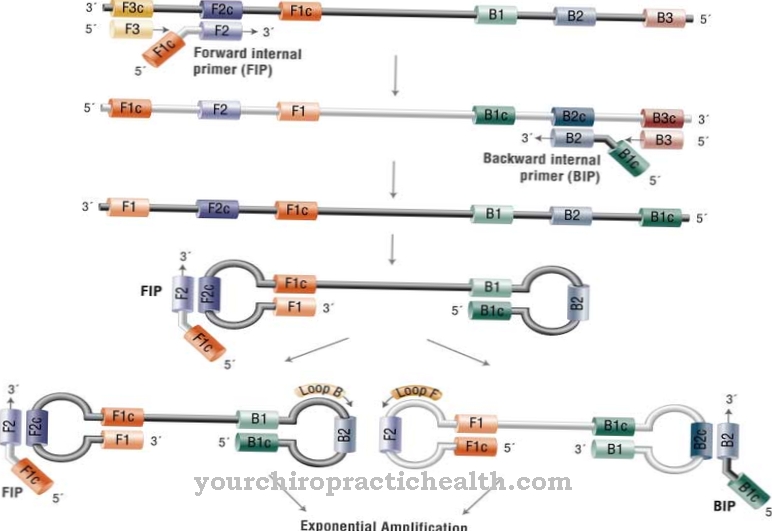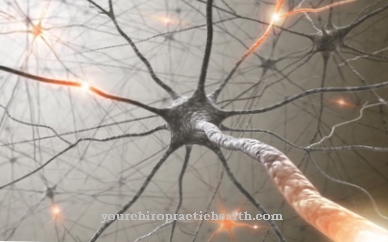The Summation is a body process within the visual process. The following article deals with the definition of terms as well as the function of the summation and examines the question of what those affected perceive when the process of the summation is disturbed? Which clinical pictures are there in this context?
What's the summation?
The summation is a calculation process in (human) optical perception. It is one of the ways in which the retina of the eye can adapt to changing light conditions.
Function & task

To understand what role the summation plays, the structure of the retina should first be explained. The human retina is estimated to be made up of 120 million rods and 6 million cones. The rods are responsible for twilight, night and movement vision. The cones are only stimulated at higher light intensities and are responsible for color vision.
A retinal cross-section shows the ganglion cells in the uppermost layer, which unite in the blind spot to form the optic nerve. This is followed by a layer of switching cells that play a role in various offsetting processes in the retina, the receptive fields and the process of summation. This layer consists of three different cell types. The bipolar cells connect the rods and cones with the ganglion cells. The horizontal cells connect light-sensing cells with each other, while the amacrine cells connect ganglion cells with each other. After the switching cell layer follows the layer of the light-sensing cells, the rods and cones. You are therefore not directly exposed to the incident light.
The parts of the visual sense cells that are constantly engaged in the visual process are stuck outwards in the black retinal pigment epithelium - which is visible through the pupil opening - and are nourished by it. The macula is the most metabolically active area in the human body.
The distribution of the rods and cones is different and depends on their function in the retina. In the middle of the retina, in the optical axis, is the pit of vision, also called the fovea centralis. Only cones can be found here, there are no sticks. In the adjacent area of the macula, the yellow spot, visual acuity is already rapidly decreasing. Here, depending on the distance to the center, fewer and fewer cones and more rods are interconnected. The vast majority of rods occur outside of the macula.
After "only" about 1 million ganglion cells are available, these are interconnected in clusters - receptive fields - with the 126 million sensory cells. In the fovea centralis, a cone cell is connected to a ganglion cell for maximum visual acuity. In the adjacent area of the macula, there are smaller receptive fields, in which about 20-100 cones with 3-15 bipolar cells and 1 ganglion cell network in a receptive field. The basis is the knowledge that a bipolar cell is networked with a ganglion cell: for a receptive field of the cones, the ratio is about 1: 6. In contrast, around 15-30 rods form a receptive field with a bipolar cell.
Now the summation comes into play. In addition to dark adaptation and light adaptation, the summation is another adaptation process of the human retina, regulating the light sensitivity of the rods and cones depending on the illuminance.
A distinction is made between spatial and temporal summation. In the spatial summation, for the rods, a incoming weak light signal amplified by the convergence in the receptive field. Many chopsticks must be active at the same time. The electrical impulse must be large enough in the larger receptive fields to trigger a stimulus in the downstream ganglion cell.
As the luminance increases, the cones are increasingly stimulated. The smaller receptive fields are addressed here. The principle of lateral inhibition applies: conversely, the signals can also weaken each other depending on where they originate - assuming that neighboring sensory cells are stimulated with different light intensities.
This principle applies to increasing the contrast: If you look at a grid of black filled squares on a white background, a slightly dark illusion appears at the intersection of the white lines, only not at the fixation point. The crossing points are surrounded by more white than the white areas that border the black squares. The excitations emanating from the crossing points are ultimately more strongly inhibited than those of the white lines between the black squares.
Temporal summation is a process in which the duration of exposure to the light stimulus at low light intensities on the retina is increased, for example by slowing down eye movements or prolonged fixation.
You can find your medication here
➔ Medicines for eye infectionsIllnesses & ailments
In the case of some diseases, these control processes in the retina can no longer be carried out in the intended quality or completely. For example, the person affected is massively blinded because control processes in the retina no longer work. The contrast processing does not proceed as usual, as described in the test with the black squares on a white background: The illusions of the black areas are less intense. The person concerned is also likely to have great problems adjusting when moving from a bright room to a dark one or vice versa. Or when he crosses an intersection with an avenue of trees on a sunny day. Or he is about to cross the intersection and suddenly stands in the shadow of a house.
Diseases that affect the control process of the retina are those in which the layers of ganglion cells, switching cells, visual sense cells and retinal pigment epithelium that are directed in the retinal cross-section are no longer present in this form.
As a rule, when looking at the fundus with the ophthalmoscope, the ophthalmologist should see these irregularities in the structure of the retina in the form of hyper- or depigmentation. These can be limited locally to the macula or locally to the retinal periphery. Some retinal dystrophies progress from the periphery to the center of the visual field or vice versa. Optical coherence tomography, which shows a cross section of a large part of the retina, should also be able to provide more precise information. Fundus autofluorescence (FAF) is able to depict normally functioning retinal areas that function outside of the norm. The FAF ultimately also represents the visual field boundaries or smaller defects, the scotomas. This examination records the accumulation of lipofuscin in the retina, which should normally be disposed of.
If a disease is suspected that is related to the processing of sensory stimuli in the retina, the patient is examined in the retinal laboratory. The following are used here: Dark adaptation according to Goldmann-Weekers, to check how the rods react to low light intensities. If there is any suspicion that processes in switching cells and ganglion cells have been affected, the VEP can be used. The patient observes a black and white honeycomb pattern that is changing ever faster on a monitor. The multifocal ERG (mfERG) checks the total response or cell response in the macula. The ERG is a derivation of the total response of the retina of the rods and the cones on the basis of scotopic and photopic stimulation of the sensory cells and derivation of the potentials.
In some cases of infantile cerebral palsy, the retina behaves as if it had retinitis pigmentosa and mimics the course.



























